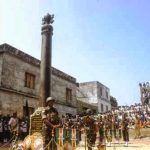RULING THE SKIES
ABSOLUTE AIR SUPERIORITY IN BANGLADESH, 1971
[An Indian Air Force veteran recounts his part in the war]
Gp Capt Hemant Sardesai, Vr C (Retd)
In November 1971 I was a young flight lieutenant of the Indian Air Force who had just completed operational flying training on Mig 21 Type 77 aircraft to become a fully qualified fighter pilot to undertake day-and-night operations. My unit, No 4 Squadron AF, was located in Tezpur, Assam. With the war imminent, we were moved during the month to Guwahati, which was closer to erstwhile East Pakistan where our target areas lay. Once the balloon went up on 03 December we were asked to gear up for action from next morning. The strike plans for various targets were finalized by late evening.
I went out on my first-ever operational mission against the enemy on 04 December. It was a strike on a Pak Army Brigade Headquarters in Rajendraganj-Mahendraganj area. We were assisted by an FAC (Forward Air Controller), an air force pilot attached to the army units to assist them in selecting targets and guiding the attacking aircraft on to them when required. I remember reporting of flak coming at me as I went in for the first attack. “What did you expect?” Came the prompt response; “Chocolates?” An obvious rebuke for breaking radio silence; thereafter I learned to keep my mouth shut and get on with the job. Our sortie carried out 3 – 4 attacks and each time the FAC reported N. 2 (that was me) right on target. Therefore we repeated the attack with all other aircraft too homing in on where I was firing. The enemy Brigade HQ, by now more or less neutralized by the air attack, was captured by our army with comparative ease. They took 160-odd personnel prisoner and captured a vast quantity of arms and ammunition.
During 04 – 05 December we too suffered some casualties. Some of our aircraft were shot down or damaged while they went in for front gun and rocket attack on Tezgaon and Kurmitola airfields by ack ack and even small arms fire while some others attacking other Pak Army targets were brought down by intercepting PAF fighters. A number of casualties occurred while the aircraft dived for weapon delivery and pulled out thereafter flying as low as 300 – 500 feet above ground rendering themselves vulnerable to ground fire. Therefore the tactics was changed from the next day, 06 December. We now went in for steep glide bombing attacks. Four of us, 3 other pilots and I, dived from about 12000 feet at 45-degree angle over Tezgaon runway and released two 500-kg bombs from a height of 3000 feet, thus staying out of the small arms range and remaining in the lethal range of the ack acks as briefly as possible. I carried out four missions of steep glide bombing attacks, two each over Tezgaon and Kurmitola runways. Overall the strike turned out to be a resounding success. We had rendered the runways unusable by any aircraft and not lost even a single aircraft. And PAF could no more operate their fighters from Tezgaon runway.
On 08 December we were ordered to attack an ammunition factory. However when we found the target it didn’t resemble an ammunition factory or depot. Our leader therefore chose not to destroy something that might turn out to be not lethal at all and could very well prove to be of use in the reconstruction of the country after the war. That left us with the option of flying back to base with the 500-kg bombs. Landing the aircraft with this additional load was a tricky business with the inherent risk of the bomb getting accidentally dropped on the runway which could cause havoc. Three of the aircraft landed safely (a rare instance of live bombs being brought back and the pilots executing safe landings with the load), but the fourth, running low on fuel, had to drop the bomb (in a safe state) before landing safely at Guwahati.
I did a total of 21 missions during day and one by night, striking a variety of targets. The night mission, carried out on 12 December, was undertaken to flush out a mercenary pilot who landed at an unmarked airfield at Narsingdi to the north-east of Dacca reportedly to fly Pak Eastern Army Commander General A A K Niazi and the rest of their top brass out of Dacca in their escape bid to get to Rangoon. We executed the mission with three aircraft flying one after the other at intervals of two and a half hours, each firing two air-to-air missiles in the general direction of the ‘ghost’ runway. The message was clear enough for the pilot who took off post-haste with no one else on board. The next morning I led a four-aircraft strike over this runway and rendered it unusable by any aircraft. On the following day, 14 December, we attacked the Governor’s house with rockets. All four aircraft delivered 32 rockets each from different directions in four dives over the massive bungalow. There wasn’t any more fight left in the enemy and on 16 December the world saw General Niazi with a nearly a hundred thousand troops of his surrender to the Indian Army unconditionally.
I had played my role in the war; 11counter air missions including one at night, 8 offensive air support missions and 3 air defence missions – part of the historic feat that crowned the Indian Air force as absolute masters of the Bengal skies in the war.






An excellent blog by Gp Capt Hemant Sardesai, VrC (Retd). Look fwd to many more such real life experiences.
Brig K Sampath(Retd)
Thank you.
Such a privilege to share this vivid account
Thank you; delighted that you liked our post. Keep visiting our site.